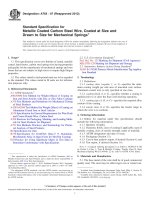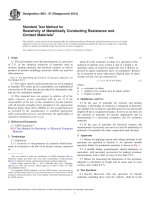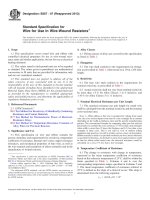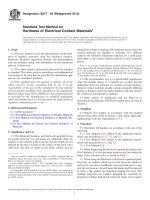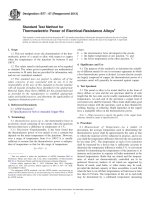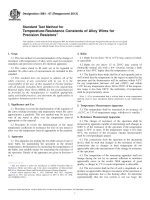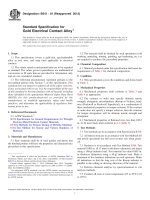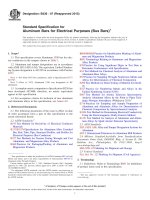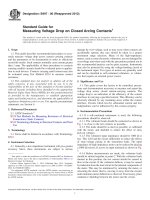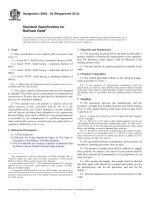Astm b 624 07 (2012)
Bạn đang xem bản rút gọn của tài liệu. Xem và tải ngay bản đầy đủ của tài liệu tại đây (84.75 KB, 4 trang )
Designation: B624 − 07 (Reapproved 2012)
Standard Specification for
High-Strength, High-Conductivity Copper-Alloy Wire for
Electronic Application1
This standard is issued under the fixed designation B624; the number immediately following the designation indicates the year of
original adoption or, in the case of revision, the year of last revision. A number in parentheses indicates the year of last reapproval. A
superscript epsilon (´) indicates an editorial change since the last revision or reapproval.
This standard has been approved for use by agencies of the Department of Defense.
1. Scope
4. Materials and Manufacture
1.1 This specification covers high-strength, highconductivity round copper-alloy wire 0.00099 to 0.0720 in.
[0.025 to 1.829 mm] in diameter, used for electronic hookup
wire. The tensile strength of the wire is 60 ksi [414 MPa]
minimum and the electrical conductivity at 20°C is 85 % IACS
minimum.
4.1 The wire shall be copper alloy of such quality and purity
that the finished product shall have the properties and characteristics prescribed in this specification. Chemical analysis of a
specific alloy is not a requirement of this specification unless
definite agreement is reached between the manufacturer and
the purchaser in the placing of individual orders.
1.2 The values stated in inch-pound units are to be regarded
as the standard. The values given in parentheses are for
information only.
1.3 This standard does not purport to address all of the
safety concerns, if any, associated with its use. It is the
responsibility of the user of this standard to establish appropriate safety and health practices and determine the applicability of regulatory limitations prior to use.
5. General Requirements
5.1 Tensile Properties—The minimum breaking strength
and elongation of the conductor shall be as prescribed in Table
1. Breaking strengths of intermediate sizes may be calculated
in accordance with Explanatory Note 1.
5.2 Electrical Resistance—The electrical resistance of the
wire at a temperature of 20°C shall not exceed the values in
Table 1. Resistances of intermediate sizes may be calculated in
accordance with Explanatory Note 2.
2. Referenced Documents
2.1 ASTM Standards:2
B193 Test Method for Resistivity of Electrical Conductor
Materials
E8 Test Methods for Tension Testing of Metallic Materials
5.3 Diameter—The wire size shall be expressed as the
diameter of the wire in decimal fractions of an inch to the
nearest 0.0001 in. [0.003 mm]. For diameters under 0.0100 in.
[0.254 mm], the wire shall not vary from the specified diameter
by more than 60.0001 in. [0.003 mm]. For diameters 0.0100
in. [0.254 mm] and over, the wire shall not vary from the
specified diameter by more than 61 %, expressed to the
nearest 0.0001 in. [0.003 mm].
3. Ordering Information
3.1 Orders for wire furnished to this specification shall
include the following information:
3.1.1 Quantity (pounds or kilograms),
3.1.2 Wire size (Table 1),
3.1.3 Place of inspection (Section 7),
3.1.4 Package size (Section 9), and
3.1.5 Special marking, if required (Section 9).
5.4 Joints—Joints necessary to processing shall be of such
quality that all requirements of this specification are met.
5.5 Finish—The finished material shall be free of defects
that detract from the normal end use or longevity of the
product. The material shall be smooth, bright, clean, and free of
laps, slivers, seams, scratches, and other imperfections not
consistent with good commercial practice.
1
This specification is under the jurisdiction of ASTM Committee B01 on
Electrical Conductors and is the direct responsibility of Subcommittee B01.04 on
Conductors of Copper and Copper Alloys.
Current edition approved Oct. 15, 2012. Published November 2012. Originally
approved in 1977. Last previous edition approved in 2007 as B624 – 07. DOI:
10.1520/B0624-07R12.
2
For referenced ASTM standards, visit the ASTM website, www.astm.org, or
contact ASTM Customer Service at For Annual Book of ASTM
Standards volume information, refer to the standard’s Document Summary page on
the ASTM website.
6. Test Method
6.1 Breaking Strength and Elongation —Conduct tension
and elongation tests in accordance with Test Methods E8 and
with a rate of loading not to exceed 10 in./min [250 mm/min].
The breaking strength shall equal or exceed the value specified
in Table 1.
Copyright © ASTM International, 100 Barr Harbor Drive, PO Box C700, West Conshohocken, PA 19428-2959. United States
1
B624 − 07 (2012)
TABLE 1 Tensile Properties and Resistance
Nominal Diameter
A
Breaking Strength, min
in.
mm
lbf
N
0.0720
0.0641
0.0571
0.0508
1.829
1.628
1.450
1.290
239
190
151
119
1065
844
670
530
0.0453
0.0403
0.0359
0.0320
1.151
1.024
0.912
0.813
94.8
75.0
59.5
47.3
0.0285
0.0253
0.0226
0.0201
0.724
0.643
0.574
0.511
0.0179
0.0159
0.0142
0.0126
Elongation,
min, % in
10 in.
or 250
mm
Resistance, max, at 20°C
V/1000 ft
V/km
9
9
9
9
2.40
3.03
3.82
4.82
7.88
9.94
12.5
15.8
422
334
265
210
9
9
9
9
6.08
7.66
9.68
12.1
19.9
25.1
31.7
39.9
37.5
29.6
23.6
18.7
167
132
105
83.1
9
9
9
9
15.3
19.5
24.3
30.8
50.2
63.7
80.0
101
0.455
0.404
0.361
0.320
14.8
11.7
9.31
7.33
65.8
52.0
41.4
32.6
9
9
9
9
38.9
49.5
61.4
78.1
128
161
202
257
0.0113
0.0100
0.0089
0.0080
0.287
0.254
0.226
0.203
5.90
4.62
3.65
2.94
26.2
20.6
16.2
13.1
9
8
8
8
97.3
124
158
195
320
408
517
643
0.0071
0.0063
0.0056
0.0050
0.180
0.160
0.142
0.127
2.31
1.81
1.43
1.13
10.3
8.1
6.3
5.0
8
8
8
7
249
317
403
508
820
1040
1330
1670
0.0045
0.0040
0.0035
0.0031
0.114
0.102
0.089
0.079
0.91
0.72
0.54
0.42
4.0
3.2
2.4
1.9
7
7
7
7
630
802
1060
1360
2080
2610
3450
4410
0.0028
0.0025
0.0022
0.0020
0.071
0.064
0.056
0.051
0.34
0.27
0.21
0.17
1.5
1.2
0.9
0.8
6
6
6
6
1670
2120
2770
3380
5490
6950
9080
11 100
0.00176A
0.00157A
0.00140A
0.00124A
0.045
0.040
0.036
0.031
0.22
0.17
0.13
0.10
1.0
0.8
0.6
0.5
4430
5650
7220
9390
14
18
23
30
0.00111A
0.00099A
0.028
0.025
0.08
0.06
0.4
0.3
...
...
...
...
...
...
...
12 000
15 400
500
500
700
800
39 200
50 500
These single ends will be hard temper.
the manufacturer and the purchaser at the time of purchase. The
manufacturer shall afford the inspector representing the purchaser all reasonable facilities to satisfy him that the material
is being furnished in accordance with this specification (Explanatory Note 3).
7.1.1 Unless otherwise agreed upon between the manufacturer and the purchaser, conformance of the wire to the various
requirements listed in Section 5 shall be determined on samples
taken from each lot of wire presented for acceptance.
7.1.2 The manufacturer, when requested before inspection,
shall certify that all wire in the lot was made under such
conditions that the product as a whole conforms to the
requirements of this specification as determined by regularly
made and recorded tests.
6.2 Resistance—Measure resistance in accordance with Test
Method B193.
6.3 Diameter—Make diameter measurements with a micrometer or equivalent caliper equipped with a vernier graduated in 0.0001 in. or 0.003 mm. Gage each coil in three places,
one near each end and one near the center. From each spool,
unreel approximately 12 ft [4 m] and gage the wire in six
places between the second and twelfth foot from the end. The
average of the measurements obtained shall be considered the
wire size specified in 5.3.
7. Inspection
7.1 General—All tests and inspections shall be made at the
place of manufacture unless otherwise agreed upon between
2
B624 − 07 (2012)
TABLE 3 Sample for Surface Finish and Packaging
7.2 Description of Inspection Terms :
7.2.1 Lot—An inspection lot shall consist of an identifiable
quantity of wire subjected to inspection at one time. Each lot
shall consist of units of wire of the same size and temper,
manufactured under essentially the same conditions at essentially the same time. The amount in any case shall not exceed
100 production units.
7.2.2 Sample—A sample is a quantity of production units
(coils, reels, and so forth) selected at random from the lot for
the purpose of determining conformance of the lot to the
requirements of this specification.
7.2.3 Specimen—A specimen is a length of wire removed
for test purposes from any individual production unit of the
sample.
Number of Units in Lot
1
4
9
16
to
to
to
to
3
8
15
25
26 to 40
41 to 65
66 to 100
Number of Units in
Sample, n
Allowable Number of
Defects in Sample to
Accept Lot, c
All
4
9
14
0
0
0
0
20
30
42
0
0
0
conforming to these requirements. If there are defects, but the
number of these do not exceed the allowable defect number c2
(Table 2) for the respective number of units in the sample, a
second sample equal to n2 shall be taken and the total defects
of the n1 + n2 units shall not exceed the allowable defect
number c2. Failure to meet this requirement shall constitute
failure to meet the conformance criteria (Explanatory Note 4).
8.1.1.1 Breaking Strength and Elongation —The breaking
strength and elongation of each of the specimens shall conform
to the requirements of 5.1 and Table 1.
8.1.1.2 Electrical Resistance—The electrical resistance
shall conform to the requirements of 5.2 and Table 1.
8.1.1.3 Diameter—The diameter of each of the specimens
shall conform to the requirements of 5.3.
8.1.2 For surface finish and packaging, when specified by
the purchaser at the time of placing the order, the sample shall
consist of a quantity of production units as shown in Table 3.
The number of units in the sample showing nonconformance to
the requirements shall not exceed the allowable defect number
c in Table 3. Failure to meet the requirements shall constitute
failure to meet the conformance criteria.
7.3 Sample Size— The number of production units in a
sample shall be as follows:
7.3.1 For breaking strength, elongation, electrical
resistance, and diameter measurements, the sample shall consist of a quantity of production units shown in Table 2 under
heading “First Sample.” From each unit, one test specimen of
sufficient length shall be removed for the performance of the
required tests.
7.3.2 For surface finish and packaging inspection, when
specified by the purchaser at the time of placing the order, the
sample shall consist of a quantity of production units as shown
in Table 3.
8. Conformance Criteria
8.1 Any lot of wire, the samples of which comply with
conformance criteria of this section, shall be considered as
complying with the requirements of Section 5. Individual
production units that fail to meet one or more of the requirements shall be rejected. Failure of a sample group from a lot to
meet one or more of the following criteria shall constitute
cause for rejection of the lot. The conformance criteria for each
of the prescribed properties given in Section 5 are as follows:
8.1.1 For breaking strength, elongation, resistance, and
diameter measurements, the sample shall consist of a quantity
of production units shown in Table 2 under heading “First
Sample.” If there are no defects, the lot shall be considered as
9. Packaging and Package Marking
9.1 Package sizes and marking shall be agreed to between
the manufacturer and the purchaser in the placing of individual
orders.
9.2 The wire shall be packaged so that it is protected against
damage or degradation in ordinary handling and shipping.
TABLE 2 Sampling for Mechanical and Electrical Tests
First Sample
Number of Units
1
4
9
16
to
to
to
to
3
8
15
25
26 to 40
41 to 65
66 to 100
Second Sample
Number of Units in
Sample, n1
Allowable Number of
Defects in Sample to
Accept Lot, c1
Number of Units in
Sample, n2
n 1 + n2
Allowable Number of
Defects in Both Samples
to Accept Lot, c2
all
4
4
5
0
0
0
0
...
...
5
9
...
...
9
14
0
0
1
1
8
12
19
0
0
0
12
18
23
20
30
42
1
1
1
3
B624 − 07 (2012)
EXPLANATORY NOTES
NOTE 1—The minimum breaking strength for any single strand conductor shall be calculated as follows:
NOTE 3—Cumulative results secured on the product of a single
manufacturer, indicating continued conformance to the criteria, are
necessary to ensure an overall product meeting the requirements of this
specification. The sample sizes and conformance criteria given for the
various characteristics are applicable only to lots produced under these
conditions.
NOTE 4—A defect should be taken as the failure of the individual
requirements (breaking strength, elongation, resistance, and diameter)
specified in 8.1.1. For example, a defect of two individual requirements
would be considered one defect of each requirement and not two defects
of the sample.
Breaking strength,min, lb 5 47 120 3 ~ mindiameter, in.! 2
or
Breaking strength,min, N 5 324.9 3 ~ mindiameter, mm! 2
NOTE 2—The maximum electrical resistance for any single strand
conductor shall be calculated as follows:
Resistance,max~ Ω/1000 ft! 5
0.01220
~ mindiameter, in.! 2
or
Resistance,max, ~ Ω/km! 5
25.83
~ mindiameter, mm! 2
ASTM International takes no position respecting the validity of any patent rights asserted in connection with any item mentioned
in this standard. Users of this standard are expressly advised that determination of the validity of any such patent rights, and the risk
of infringement of such rights, are entirely their own responsibility.
This standard is subject to revision at any time by the responsible technical committee and must be reviewed every five years and
if not revised, either reapproved or withdrawn. Your comments are invited either for revision of this standard or for additional standards
and should be addressed to ASTM International Headquarters. Your comments will receive careful consideration at a meeting of the
responsible technical committee, which you may attend. If you feel that your comments have not received a fair hearing you should
make your views known to the ASTM Committee on Standards, at the address shown below.
This standard is copyrighted by ASTM International, 100 Barr Harbor Drive, PO Box C700, West Conshohocken, PA 19428-2959,
United States. Individual reprints (single or multiple copies) of this standard may be obtained by contacting ASTM at the above
address or at 610-832-9585 (phone), 610-832-9555 (fax), or (e-mail); or through the ASTM website
(www.astm.org). Permission rights to photocopy the standard may also be secured from the ASTM website (www.astm.org/
COPYRIGHT/).
4
